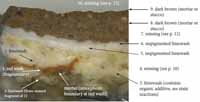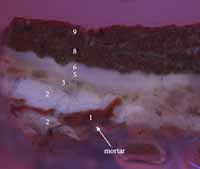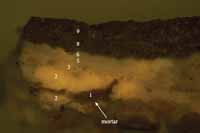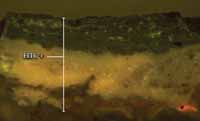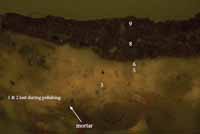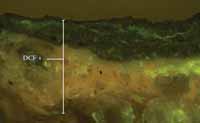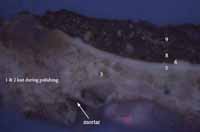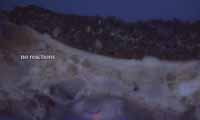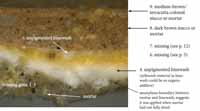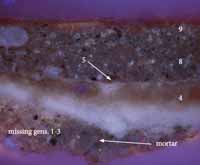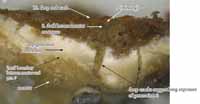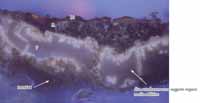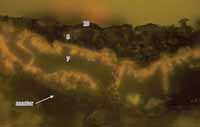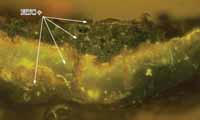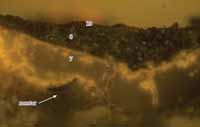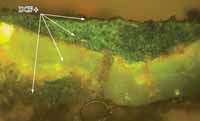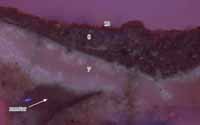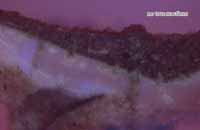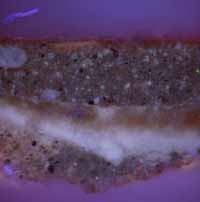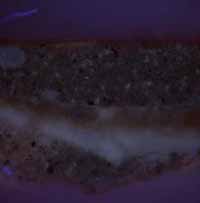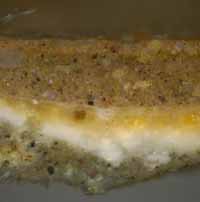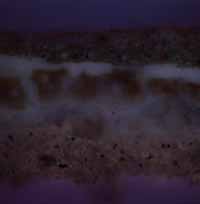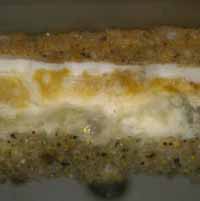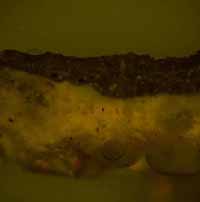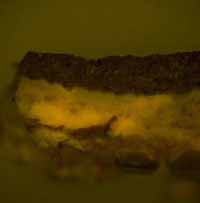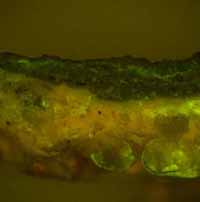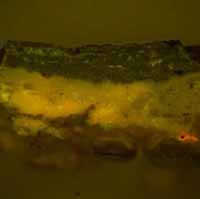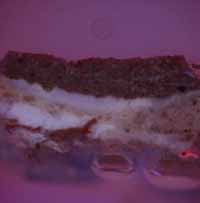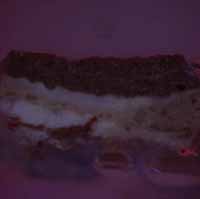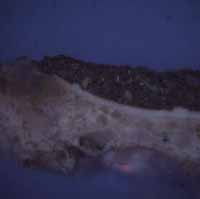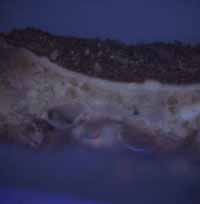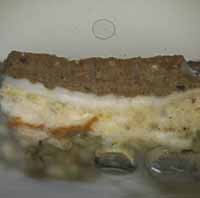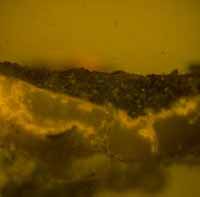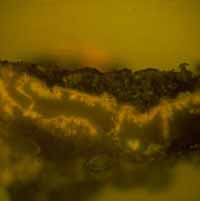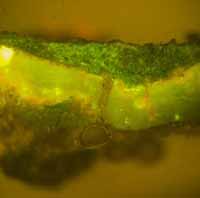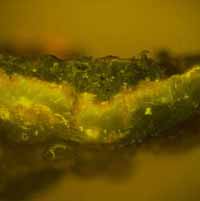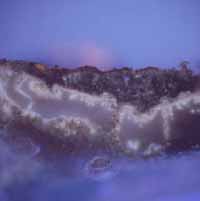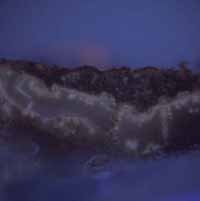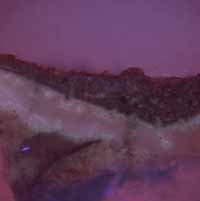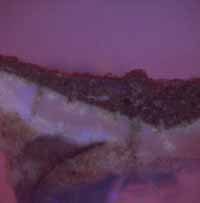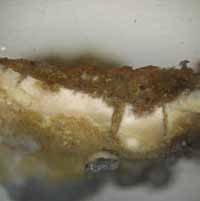Cross-Section Microscopy Analysis of Interior Paints: Margaret Hunter Shop (Block 17, Building 9), Williamsburg, VirginiaCross-section Microscopy Analysis Report: Margaret Hunter Shop (Block 17, Building 9)
Colonial Williamsburg Foundation Library Research Report Series - 1747
Colonial Williamsburg Foundation Library
Williamsburg, Virginia
2013
CROSS-SECTION MICROSCOPY ANALYSIS REPORT
Margaret Hunter Shop
Block 17, Building 9
COLONIAL WILLIAMSBURG FOUNDATION
WILLIAMSBURG, VIRGINIA
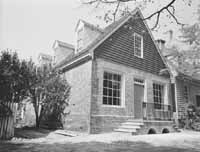 Margaret Hunter Shop [CWF historical negative collection]
Margaret Hunter Shop [CWF historical negative collection]
| Structure: | Margaret Hunter Shop, block 17, building 9 |
|---|---|
| Requested by: | Dani Jaworski, Architectural Collections Specialist, Colonial Williamsburg Foundation |
| Analyzed by: | Kirsten Travers, Paint Analyst, Colonial Williamsburg Foundation |
| Consulted: | Susan L. Buck, PhD., Conservator and Paint Analyst, Williamsburg, Virginia; and Edward Chappell, Roberts Director of Architectural and Archaeological Research, Colonial Williamsburg Foundation |
| Date submitted: | June 18, 2012 |
Purpose:
The goal of this project was to use cross-section microscopy techniques to examine and characterize the washes discovered on mortar joints from the west elevation of the Margaret Hunter Shop (found by Ray Cannetti, mason).
History:1
The Margaret Hunter Shop is situated on the north side of Duke of Gloucester street. The exact date of construction is uncertain but research indicates it might have been in place c.1745, when an advertisement for sale of the property describes "The Dwelling House, Outhouses, Store Houses, &c." The latter of which may refer to the present shop. At the time of the restoration, the building had been converted to a two-story garage, and had been lengthened on the north end, and it was restored to its original story-and-a-half shop. According to CWF records, the brick surface on the west elevation, where the samples were collected from, is entirely original except where small repairs were necessary.
Procedures:
On May 29, 2012, three samples were removed from the Margaret Hunter Shop by Kirsten Travers, who was accompanied on-site by Dani Jaworski (CWF Architectural Collection Specialist), who pointed out the best areas of surviving washes. A monocular 30x microscope was used to examine the painted surfaces to determine the most appropriate areas for sampling. A microscalpel was used to remove the samples, and sampling locations were recorded and photographed. Samples were labeled and stored in small, individual Ziploc bags for transport. All samples were given the prefix "MHS", and numbered according to the Margaret Hunter Shop [CWF historical negative collection] 3 order in which they were collected (MHS 1 — MHS 3). A complete list of sample locations and photographs can be found in Appendix A.
In the laboratory, the samples were examined with a stereomicroscope under low power magnification (5x to 50x), to identify those that contained the most coating evidence and would therefore be the best candidates for cross-section microscopy. Uncast portions were retained for future examination and analysis, if necessary. The best candidates were cast in resin cubes and sanded and polished to expose the cross-section surface for microscopic examination. Please see Appendix B for sample preparation details.
Results:
This investigation found evidence of colored lime-based washes and mortar or stucco residues on the exterior of the Margaret Hunter shop. Some of the evidence is fragmentary, and none of the samples contained the same stratigraphy, although all had coatings in common. This suggests that some washes might have worn away in certain areas. This is very common for lime-based washes, which are brittle in nature. Comparison of the three samples (MHS 1 — MHS 3) suggests that at least ten generations are extant. The first generation appears to be a red-colored wash, which was fragmentary and present in only one sample (MHS 2). Generations 2-7 are unpigmented (white) limewashes. Generation 8 and 9 are thick, dark brown-coatings which contain a good deal of aggregates, suggestive of a stucco or mortar residue. Generation 10 is a thin, deep red wash which was present in only one sample (MHS 3). All of these coatings tested positively for oil and protein-based additives, which might have improved the working consistency and/or the durability of the washes when dry.
The first generation red-colored wash appeared to have been applied when the mortar was still wet. If this mortar is original, than this could be a first-period finish. However, this evidence was very fragmentary and additional samples should be taken and examined before making further conclusions.
The results are shown on the following pages. Coating stratigraphies have been annotated according to finish generation, and other important characteristics were also labeled. The analytical results and pertinent observations are discussed adjacent to the photomicrographs. All findings are interpreted in the conclusion.
Sample: MHS 2
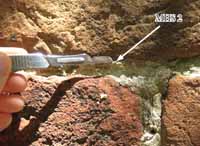 Description: West elevation, exterior brick surface, wash residue on mortar joint, 100" from north end, 36" up from ground
Description: West elevation, exterior brick surface, wash residue on mortar joint, 100" from north end, 36" up from ground
Discussion:
Sample MHS 2 was taken from an area of accumulated coatings that had a medium-brown/terracotta color on the surface.
The first generation is a red wash, which is attached to a small fragment of mortar at the bottom of the sample. The evidence is fragmentary, but there does appear to be a 'soft' boundary between the red wash and the mortar, suggesting the red wash was applied when the latter was still wet. This red wash appears to be encapsulated by generation 2, an unpigmented (white) limewash that was applied later, when generation 1 had already been allowed to deteriorate and fragment. Generation three appears to be an unpigmented limewash, but it has a yellowish color in reflected visible light and a dimmer autofluorescence in UV light, suggestive of an organic additive, such as an oil.
Generation 4 is missing from this sample (in sample MHS 1, this was an unpigmented limewash that had a yellowish color in visible light, suggestive of an organic additive (see p. 10)). Generations 5 and 6 are unpigmented (white) limewashes. Generation 7 is missing from this sample (in sample MHS 3, this was a very deteriorated unpigmented limewash with an unusual autofluorescence around its edges, which might result from an organic additive (see p. 12)).
Generations 8 and 9 are thicker, dark brown-colored coatings with a good deal of aggregate, suggestive of a mortar or stucco.
Sample MHS 2 was stained with fluorochromes to characterize the binding media. All extant coatings tested positively for proteins (FITC+) and lipids (oils, DCF+). No reactions were observed for carbohydrates with TTC.2
MHS 2: west elevation, mortar joint, 100" from north end, 36" up from ground
Sample: MHS 1
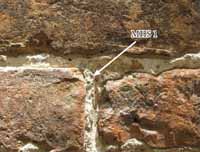 Description: West elevation, exterior brick surface, wash residue on mortar joint, 17'5" from north end, 39" up from ground
Description: West elevation, exterior brick surface, wash residue on mortar joint, 17'5" from north end, 39" up from ground
Discussion:
Sample MHS 1 was taken from an area of accumulated coatings that had a medium-brown/terracotta- colored surface.
This sample is missing some of the washes identified in sample MHS 2. For instance, the first generation red wash is not present here. Instead, the earliest generation is an unpigmented (white) limewash that contains a yellowish phase that is dark in reflected UV light, suggestive of an organic media (such as an oil), that might have been added to improve working properties and/or durability. This limewash is designated generation 4. The amorphous, or 'soft' boundary between this limewash and the mortar suggests that the limewash was applied to the mortar when it was still wet. However, this is in conflict with the evidence in sample MHS 2 (see p. 5), which suggested that the red wash was the first coating applied to the wet mortar. This might suggest that this area is a later repair. Additional samples would need to be examined to resolve this inconsistency.
The next generation is an unpigmented (white) limewash that appears to align with generation 5 in sample MHS 2. This generation is thin in this photomicrograph but was observed to be rather thick in other areas of the sample (not pictured). Generations 8 and 9 are the thick, dark brown coatings that contain a good deal of aggregate, suggestive of a mortar or stucco, rather than a limewash. These coatings were also seen in the other samples.
This sample was not stained with fluorochromes.
Sample: MHS 3
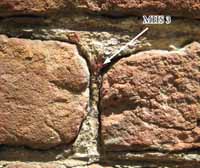 Description: west elevation, exterior brick surface, wash residue on mortar joint, 18'3" from south end, 43" up from ground
Description: west elevation, exterior brick surface, wash residue on mortar joint, 18'3" from south end, 43" up from ground
Discussion:
Sample MHS 3 was taken from a remnant of accumulated coatings that had a deep red color on the surface.
The cross-section suggests that this sample is missing many of the finish generations seen in sample MHS 2. The mortar is visible at the bottom of the stratigraphy, followed by an unpigmented (white) limewash that exhibits increased autofluorescence at its edges. This limewash was not present in any of the other samples. It is designated generation 7. This limewash exhibits deep cracks in its surface that extend all the way down to the mortar, suggesting this generation was exposed for a very long period of time and become very deteriorated. The dim autofluorescent phase in its center suggests an organic media, such as oil, might have been added (see fluorochrome staining results, discussed below). The eighth generation dark brown stucco or mortar is seen to flow into cracks in the seventh generation. It is possible that generations 5 and 6 (other unpigmented limewashes) are missing because they were completely worn away from this area. Generation 9, the second medium-brown/terracotta-colored stucco or mortar (seen in MHS 1), was missing from this sample. The deep red wash which was visible at the surface during sampling is present at the top of the stratigraphy and is designated generation 8.
Sample MHS 3 was stained with fluorochromes to characterize the binding media. All extant coatings tested positively for proteins (FITC+) and lipids (oils, DCF+). No reactions were observed for carbohydrates with TTC.
MHS 3: west elevation, mortar joint, 18'3" from south end, 43" up from ground
MHS 3: fluorochrome staining results
Conclusions:
The three samples collected from the mortar joints on the west elevation of the Margaret Hunter shop show definite evidence of lime-based washes in white (unpigmented), and red colors. Some of the more recent coatings include what could be a terracotta-colored stucco, or mortar residues from a repair. None of the samples contained the same stratigraphy, although all had coatings in common which helped establish the stratigraphy. It is very possible that the complete finish history is not intact anywhere on the building. This is very common for lime-based washes, which are brittle in nature and wear away easily.
The stratigraphy is as follows:
| Generation | Description | Comments |
|---|---|---|
| 10 | deep red wash | MHS 3 only, FITC+, DCF+ |
| 9 | medium-brown/terracotta-colored stucco or mortar | MHS 1 and 2, FITC+, DCF+ |
| 8 | dark brown stucco or mortar | very thick, present in all samples, FITC+, DCF+ |
| 7 | unpigmented (white) limewash | MHS 3 only, very deteriorated, FITC+, DCF+ |
| 6 | unpigmented (white) limewash | MHS 2 only, FITC+, DCF+ |
| 5 | unpigmented (white) limewash | MHS 1 and 2 only, FITC+, DCF+ |
| 4 | unpigmented (white) limewash | MHS 1 only, not stained |
| 3 | unpigmented (white) limewash | MHS 2 only, FITC+, DCF+ |
| 2 | unpigmented (white) limewash | MHS 2 only, FITC+, DCF and TTC rxn unknown |
| 1 | red wash | MHS 2 only, might have been applied when mortar was still wet, FITC+, DCF and TTC rxn unknown |
| mortar | — | — |
Samples MHS 2 and MHS 3 were stained with fluorochromes to characterize binding media. Neither of these samples contained generation 4, so its nature is unknown. All other coatings tested positively for the presence of oils (DCF+) and proteins (FITC+). These materials might have been added to enhance the working properties of the coatings or to increase their durability when dry. No reactions were observed for carbohydrates (TTC-). (It should be noted that generations 1 and 2 were present only in sample MHS 2. However, after testing positively for proteins, these coatings were lost during re-polishing. Therefore, their reactions to DCF and TTC are unknown). These findings should be confirmed with an instrumental technique such as Fourier-transform infrared spectroscopy (FTIR) and/or gas chromatography-mass spectrometry (GC-MS).
Footnotes
References:
- Reed, W. Jr. 1946. "Margaret Hunter Shop, Architectural Report, Block 17, Building 9, Lot 52." Colonial Williamsburg Foundation Research Report Series — 1362.
- Stephenson, M. 1948. "Russell House and Margaret Hunter Shop Historical Report, Block 17, Building 31 & 9." Colonial Williamsburg Foundation Research Report Series — 1363.
- Whiffen, M. 1984. The Eighteenth-Century Houses of Williamsburg, Revised Ed. The Colonial Williamsburg Foundation, Williamsburg, Virginia.
Appendix B. Sample Memorandum
Cc: Susan Buck
From: Kirsten Travers
Date: May 29, 2012
Re: Samples of exterior brick washes from the Margaret Hunter Shop and the Grissell-Hay Kitchen
Today I collected three samples of what looked to be color-washes from the exterior of two buildings in the historic area: the Margaret Hunter Shop and the Grissell-Hay Kitchen. Dani Jaworski met me at the Margaret Hunter Shop to show me where Ray Cannetti had found remnants of washes earlier, on the west elevation. I was alone at the Grissell-Hay Kitchen.
Margaret Hunter Shop
- MHS 1: West elevation, wash residue on brick joint, 17'5" from north end, 39" from ground
- MHS 2: West elevation, wash residue on brick joint, 18'3" from south end, 43" from ground
- MHS 3: West elevation, wash residue on brick joint, 8'4" from north end, 36" from ground
Notes: Dani mentioned that Ray C. also saw wash residues on the east elevation, higher up. This elevation was not sampled since it was not accessible, and it was assumed that the finishes would be the same.
Grissell-Hay Kitchen
- GHK 1: South elevation, wash residue on brick, 3rd brick course from top, 3rd brick in from the east
Notes: Met with Matt Webster after sampling, who informed me that the 'big question' is if the east elevation is original. I will return to sample this elevation when the masons work on that side, in June.
Appendix C. Procedures
Binding Media Analysis using Fluorochrome staining:
Fluorochrome stains adapted from the biological sciences were used to characterize the paint binding media (oils, proteins, carbohydrates), in layers within the cross-section sample. The following stains were used in this analysis:
- 2,7 Dichlorofluorescein (DCF): 0.02% w/v in ethanol. Fluorescent labeling reagent for lipids, particularly drying oils. One drop of stain was applied to the surface of the sample, blotted immediately, and cover-slipped with mineral spirits. The reaction was observed with the B2A filter cube (EX 450-490nm, BA 520nm). This stain exhibits a yellow-green fluorescence where lipids are present.
- Triphenyl tetrazolium chloride (TTC): 1.0% w/v in ethanol. Labeling reagent for carbohydrates (gums, starches, cellulosic thickeners). One drop of stain was applied to the surface of the sample, blotted dry, and allowed to sit for approximately 45 seconds before cover-slipping, (must be allowed to react with atmospheric moisture for reaction to move forward). The reaction is observed under reflected UV light conditions (EX 330-380nm, BA 420nm). A dark red-brown color is seen where carbohydrates are present.
- Fluorescein isothiocyanate (FITC): 0.02% w/v in anhydrous acetone. Fluorescent labeling reagent for proteins. One drop of stain was applied to the surface of the sample, blotted immediately, and coverslipped with mineral spirits. The reaction was observed using the B-2A filter cube (EX 450-490nm, BA 520nm). A positive reaction is a bright yellow-green fluorescence.
